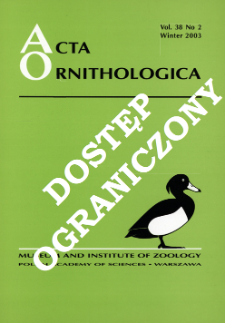- Search in all Repository
- Literature and maps
- Archeology
- Mills database
- Natural sciences
Advanced search
Advanced search
Advanced search
Advanced search
Advanced search

Object
Title: The decline of the bullfinch Pyrrhula pyrrhula in Britain: is the mechanism known?
Creator:
Siriwardena, Gavin M. ; Freeman, Stephen N. ; Crick, Humphrey Q. P.
Date issued/created:
Resource type:
Subtitle:
Acta Ornithologica, vol. 36, no. 2 ; Jaki jest mechanizm spadku liczebności populacji gila w Wielkiej Brytanii?
Contributor:
Polska Akademia Nauk. Muzeum i Instytut Zoologii
Publisher:
Muzeum i Instytut Zoologii PAN
Place of publishing:
Description:
Bibliogr. p. 151-152 ; P. [143]-152 : ill. ; 27 cm ; Abstract in Polish. Taxa in Latin
Type of object:
Abstract:
The Bullfinch has declined in Britain and elsewhere in Europe, but definitive evidence about the cause and demographic mechanism has yet to be published. We review current knowledge, concentrating on analyses of demography, and present new integrated population modelling analyses designed to reveal the demographic changes most important in the decline. It is likely that changes in brood size and clutch size have not been important and our models suggest that the decline can be explained without invoking variation in numbers of breeding attempts or post-fledging survival rates. However, although changes in the egg period daily nest failure rate provide the best explanation for population change during the years of steepest decline, nestling period failures, adult survival and first-year survival could all have been equally important. Egg period nest failure rates have been higher in the preferred habitat, woodland, than in farmland and have fallen over time in farmland, where a larger decline has occurred (65% versus 28%), arguing against a causal link with abundance. Despite evidence for a negative effect of agricultural intensification on Bullfinch presence, little evidence exists clearly linking any demographic rate to environmental change, and agricultural land-use has had little effect on nest failure rates. Predation appears to have had no significant impact. Future work should focus on contemporary investigations of the importance of hedgerow structure and woodland understorey vegetation.
Relation:
Volume:
Issue:
Start page:
End page:
Detailed Resource Type:
Format:
Resource Identifier:
Source:
MiIZ PAN, call no. P.257, Vol. 36, No 2 ; MiIZ PAN, call no. P.4568, Vol. 36, No 2 ; click here to follow the link
Language:
Rights:
Rights Reserved - Restricted Access
Terms of use:
Digitizing institution:
Museum and Institute of Zoology of the Polish Academy of Sciences
Original in:
Library of the Museum and Institute of Zoology of the Polish Academy of Sciences
Projects co-financed by:
Programme Innovative Economy, 2010-2014, Priority Axis 2. R&D infrastructure ; European Union. European Regional Development Fund
Access:
Object collections:
- Digital Repository of Scientific Institutes > Partners' collections > Museum and Institute of Zoology PAS > Scientific Journals
- Digital Repository of Scientific Institutes > Partners' collections > Museum and Institute of Zoology PAS > MIZ PAN Publications > Acta Ornithologica
- Digital Repository of Scientific Institutes > Literature > Journals/Articles
Last modified:
Feb 4, 2025
In our library since:
May 23, 2014
Number of object content downloads / hits:
54
All available object's versions:
https://rcin.org.pl./publication/61357
Show description in RDF format:
Show description in RDFa format:
Show description in OAI-PMH format:
| Edition name | Date |
|---|---|
| Decline of the bullfinch Pyrrhula pyrrhula in Britain: is the mechanism known? / Siriwardena, Gavin M. | Feb 4, 2025 |
Objects Similar
Tomiałojć, Ludwik (1939– )
Zimka, Jerzy Roman ( –2011)
Nankinov, Dimitr Nikolov
Czarnecki, Zygmunt (1930–1982)
Kania, Wojciech Maria (1943– )
Božko, Svetlana Ivanovna
Sokołowski, Jan (1899–1982)
Böhner, Jörg Wistel-Wozniak, Alexandra

 INSTYTUT ARCHEOLOGII I ETNOLOGII POLSKIEJ AKADEMII NAUK
INSTYTUT ARCHEOLOGII I ETNOLOGII POLSKIEJ AKADEMII NAUK
 INSTYTUT BADAŃ LITERACKICH POLSKIEJ AKADEMII NAUK
INSTYTUT BADAŃ LITERACKICH POLSKIEJ AKADEMII NAUK
 INSTYTUT BADAWCZY LEŚNICTWA
INSTYTUT BADAWCZY LEŚNICTWA
 INSTYTUT BIOLOGII DOŚWIADCZALNEJ IM. MARCELEGO NENCKIEGO POLSKIEJ AKADEMII NAUK
INSTYTUT BIOLOGII DOŚWIADCZALNEJ IM. MARCELEGO NENCKIEGO POLSKIEJ AKADEMII NAUK
 INSTYTUT BIOLOGII SSAKÓW POLSKIEJ AKADEMII NAUK
INSTYTUT BIOLOGII SSAKÓW POLSKIEJ AKADEMII NAUK
 INSTYTUT CHEMII FIZYCZNEJ PAN
INSTYTUT CHEMII FIZYCZNEJ PAN
 INSTYTUT CHEMII ORGANICZNEJ PAN
INSTYTUT CHEMII ORGANICZNEJ PAN
 INSTYTUT FILOZOFII I SOCJOLOGII PAN
INSTYTUT FILOZOFII I SOCJOLOGII PAN
 INSTYTUT GEOGRAFII I PRZESTRZENNEGO ZAGOSPODAROWANIA PAN
INSTYTUT GEOGRAFII I PRZESTRZENNEGO ZAGOSPODAROWANIA PAN
 INSTYTUT HISTORII im. TADEUSZA MANTEUFFLA POLSKIEJ AKADEMII NAUK
INSTYTUT HISTORII im. TADEUSZA MANTEUFFLA POLSKIEJ AKADEMII NAUK
 INSTYTUT JĘZYKA POLSKIEGO POLSKIEJ AKADEMII NAUK
INSTYTUT JĘZYKA POLSKIEGO POLSKIEJ AKADEMII NAUK
 INSTYTUT MATEMATYCZNY PAN
INSTYTUT MATEMATYCZNY PAN
 INSTYTUT MEDYCYNY DOŚWIADCZALNEJ I KLINICZNEJ IM.MIROSŁAWA MOSSAKOWSKIEGO POLSKIEJ AKADEMII NAUK
INSTYTUT MEDYCYNY DOŚWIADCZALNEJ I KLINICZNEJ IM.MIROSŁAWA MOSSAKOWSKIEGO POLSKIEJ AKADEMII NAUK
 INSTYTUT PODSTAWOWYCH PROBLEMÓW TECHNIKI PAN
INSTYTUT PODSTAWOWYCH PROBLEMÓW TECHNIKI PAN
 INSTYTUT SLAWISTYKI PAN
INSTYTUT SLAWISTYKI PAN
 SIEĆ BADAWCZA ŁUKASIEWICZ - INSTYTUT TECHNOLOGII MATERIAŁÓW ELEKTRONICZNYCH
SIEĆ BADAWCZA ŁUKASIEWICZ - INSTYTUT TECHNOLOGII MATERIAŁÓW ELEKTRONICZNYCH
 MUZEUM I INSTYTUT ZOOLOGII POLSKIEJ AKADEMII NAUK
MUZEUM I INSTYTUT ZOOLOGII POLSKIEJ AKADEMII NAUK
 INSTYTUT BADAŃ SYSTEMOWYCH PAN
INSTYTUT BADAŃ SYSTEMOWYCH PAN
 INSTYTUT BOTANIKI IM. WŁADYSŁAWA SZAFERA POLSKIEJ AKADEMII NAUK
INSTYTUT BOTANIKI IM. WŁADYSŁAWA SZAFERA POLSKIEJ AKADEMII NAUK




































